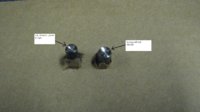Did not read through the entire thread but I thought I should post this:

On the left is the Mikes one piece rod after one summer (6000km's) and on the right the longer part of the original 2-piece rod (probably after 30 summers of riding). The ball bearing beetween the two rods seems to work wonders. Or the Mikes rod was not hardened?
I'll be using a two piece rod with a hydraulic actuator next summer (testing it...)
Pekka
On the left is the Mikes one piece rod after one summer (6000km's) and on the right the longer part of the original 2-piece rod (probably after 30 summers of riding). The ball bearing beetween the two rods seems to work wonders. Or the Mikes rod was not hardened?
I'll be using a two piece rod with a hydraulic actuator next summer (testing it...)
Pekka

